
NW Ohio, SE Michigan wind power is churning up cash
Area farmers reap rent, utilities add power sources
10/16/2011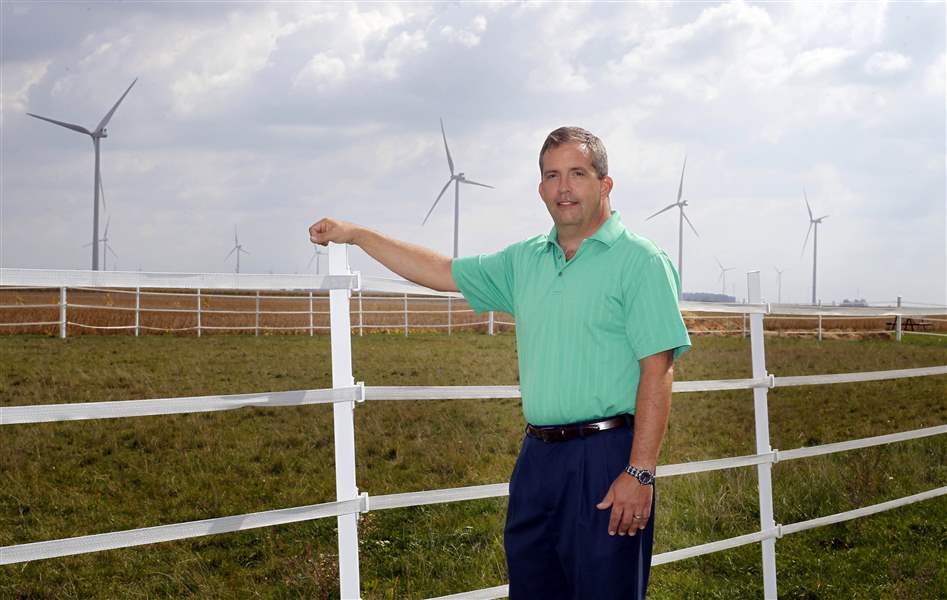
County Commissioner Tony Zartman, who lives at 4376 Road 33, stands in his Benton Township backyard where several wind turbines spin in the distance.
The Blade/Amy E. Voigt
Buy This Image
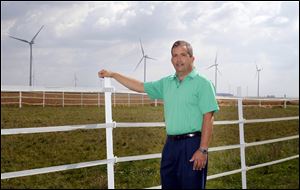
County Commissioner Tony Zartman, who lives at 4376 Road 33, stands in his Benton Township backyard where several wind turbines spin in the distance.
A transformation of the economic landscape of rural portions of northwest Ohio and southeast Michigan has begun to blossom across thousands of acres in Paulding County. Developers have erected the first several dozen of what officials say will be more than 800 wind turbines in the region that will use the wind to generate both electricity for utilities and money for local residents.
The first of the region's new cash crop — a $175 million, 55-turbine site called Timber Road II near the Indiana-Ohio border owned by EDP Renewables North America LLC— began spinning in July and generating approximately 99 megawatts of electricity to be sold to American Electric Power of Columbus. Two other nearby phases of the project promise to add 60 turbines and double the total output and investment.
The economic impact of the plans put forth for the region are as massive as the 480-foot-tall turbines with their 150-foot-long blades.
Farmers who lease their land to wind developers for as much as $500 a month for 20 years for each turbine gain a new steady source of income. Schools and local governments will receive hundreds of thousands of dollars in new annual payments in lieu of taxes from wind farms built on small pieces of tax-abated former farmland.
Hundreds of construction workers have spent much of the last two years erecting the giant monopole turbines, and a lesser number of workers will gain permanent jobs maintaining them.
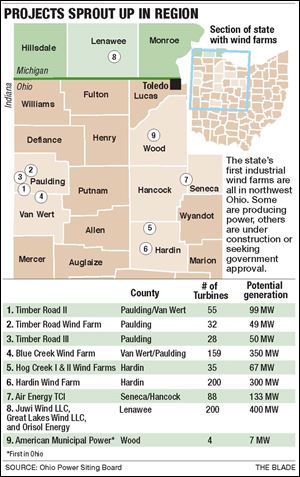
Proposed or recently in operation in northwest Ohio are seven farms with nearly 600 turbines, projects that are estimated to cost more than $2 billion.
Another project in Michigan would mean an additional 200 turbines and an estimated $800 million investment.
Altogether, the area farms will have the capacity to generate 1,450 megawatts, enough to power nearly 1.5 million homes during peak wind conditions.
By comparison, the Davis-Besse nuclear power plant produces 905 megawatts of electricity.
All of the wind farm projects in Ohio are in the northwest corner of the state, and the largest are in Paulding and Hardin counties, near the Indiana line. A typical 100-megawatt project usually represents about a $200 million investment overall, said Matt DaPrato, an analyst with IHS Emerging Energy Research in Boston.
The investment and costs, though, are not what draw the scores of gawkers to Paulding County's new giant spinning sentries.
"It's just unbelievable," Payne Mayor Nancy Speice said, referring to out-of-town visitors who turn off nearby U.S. 24 to inspect the turbines. "They want to know what it sounds like," she said.
She takes them to the foot of a turbine built on farmland she owns so they can hear for themselves the "whoosh" and "swish" of the blades.
Near the Timber Road II project about 80 miles southwest of Toledo, the Blue Creek Wind Farm is bringing $1.1 million in annual lease payments to local landowners, $2.7 million in annual local taxes, 15 to 20 new permanent jobs, and more than 300 construction jobs to the area.
A dozen and a half Ohio companies are supporting or supplying the construction effort, according to developer Iberdrola Renewables of Portland, Ore. Iberdrola has an agreement with a FirstEnergy Corp. subsidiary to purchase 100 of that project's planned 304 megawatts.
Paul Copleman, a spokesman for Iberdola Energy, said the company's Blue Creek Wind Farm along the Paulding and VanWert county line is a $600 million investment and the largest wind field in the company's portfolio.
Although he refused to discuss the profit margins of such projects, Mr. Copleman said they "have to build a project that makes economic sense, but it also has to make sense in the market. Otherwise we don't have customers."
Because of the capital-intensive nature of the industry, one of the ways to do that is to lock in long-term contracts with customers such as FirstEnergy, which agreed to purchase a third of the field's total output for the next 20 years.
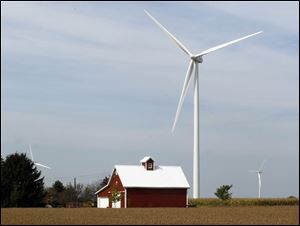
Three wind turbines on farmland in Benton Township are among several in Paulding County.
"Wind has installed 35 percent of the new [electrical] generation across the nation over the last four years, more than coal and nuclear combined, and second only to natural gas," said Ellen Carey, a spokesman for the American Wind Energy Association, a trade group. "These projects are attractive to utilities because they use no fuel, so utilities can lock in 20-year contracts [for supplies of electricity] at a fixed rate, and that's a great hedge for them."
Mr. DaPrato, the IHS analyst, said Ohio and Michigan have mandated standards that specify how much electricity used in the states should come from renewable sources, and that is driving wind-power development.
Ohio passed its standard in 2008, requiring utilities to secure 12.5 percent of their energy supply from renewable sources by 2025.
Michigan law requires utilities there to get 10 percent of their power from renewable resources by 2015.
"The cost of wind has come down dramatically over the last couple years, and it's getting to the point where it's getting very attractive to utility companies from a diversity standpoint, Mr. DePrato said.
However, although wind power has a fixed price, its impact on utility rates is limited because it is just one component of a utility's overall generation mix.
Ohio projects, he added, typically have generation costs of $50 to $60 per megawatt-hour.
Nationally, the average natural gas-fueled power plants generate electricity at a cost of $62.20 per megawatt-hour, coal-generated electricity at $95.10, nuclear generation at $114, and solar at $211.
The Ohio Power Siting Board, which decides where the wind industry projects can go, lists these projects that are already producing electricity, are approved for construction, or awaiting approval:
Air Energy TCI, of Montreal, has secured about 75 percent of about 30 square miles south and west of Arcadia that would house between 53 and 88 turbines in a 133-megawatt wind farm in Seneca and Hancock counties.
The site, about 50 miles south of Toledo, has been undergoing wind studies for two years and "looks attractive to host" a future wind farm because of its wind resources and proximity to the electrical grid, company development manager Cory Cantwell told The Blade.
Hog Creek Wind Farm LLC is working toward building up to 67 megawatts of wind generation capacity across 3,400 acres in Hardin County, featuring as many as 35 turbines about 70 miles south of Toledo.
Invenergy LLC plans to install up to 300 megawatts of wind generation capacity across 23,000 leased acres in Hardin County, with a project to construct up to 200 turbines 85 miles south of Toledo.
A subsidiary of EDP Renewables plans to install up to 35 turbines, or 48.6 megawatts of wind generation capacity, across 5,700 acres in Paulding County.
A subsidiary of Iberdrola Renewable, Inc. is pursuing a 40,500-acre project in Van Wert and Paulding counties that would use up to 159 turbines to generate up to 350 megawatts of electricity.
Such projects aren't limited to Ohio. Residents in Lenawee County's Riga, Ogden, Fairfield, and Palmyra townships are debating the merits of three wind farms that would erect about 200 turbines in the southeast portion of the county just 20 miles northwest of Toledo.
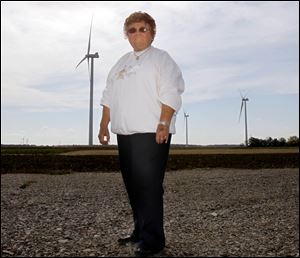
Village of Payne Mayor Nancy Speice owns two of the several wind turbines in Benton Township.
However, the project has elicited strong local reactions from advocates both for it and against it and is awaiting the outcome of a Nov. 8 vote in Riga Township.
These projects follow development of Ohio's first four utility-scale wind turbines, installed in 2003 and 2004 at the Wood County landfill, five miles west of Bowling Green, each producing about 1.7 megawatts.
That small-scale wind farm was developed by American Municipal Power.
Air Energy's Mr. Cantwell said that although northwest Ohio and southeast Michigan may not have the sustained winds of the Great Plains, its proximity to the existing electrical grid and to demand for the electricity that the project will produce make locations in the region attractive for development.
"The lay of the land is suitable for turbines," Mr. Cantwell said. The Canadian company is pursuing similar-sized projects in Crawford County (which borders Seneca County on the south) as well as in Michigan between Lansing and Grand Rapids.
According to the American Wind Energy Association, Ohio has 3,683 megawatts of potential wind-generated electricity "in queue," waiting for either regulatory approval or economic conditions, and Michigan has 2,518 megawatts in the same status.
As the wind turbines have sprouted across the region, they've sparked a massive debate among area residents about whether the giant sentinels are too large a disruption in an otherwise bucolic landscape.
In Lenawee County, some residents have taken to the ballot box to try to stop the project there.
In Paulding County, Jay and Richard Schmidt are a father and son with two turbines on their land and were among the landowners approached more than two years ago by the company now named EDP Renewables about leasing land for the turbines.
Eventually they reached agreement on a 20-year lease. Although potential noise from the turbines has sparked debate in areas such as Lenawee County, the Schmidts say their two windmills don't bother them.
"It's not much louder than car noise," said Richard Schmidt, who is among 60 landowners sharing an estimated $500,000 a year in lease money from EDP, which has its own 20-year supplier contract with American Electric Power for the 99 megawatts of electricity the Timber Road II project will produce.
In a county whose population slipped below 20,000 in the last census, the presence of the turbines has benefited local contractors and injected new money into both the private and public sectors.
Pat and Dave Greulach are among those with a turbine on their land. They say that although it may be scaring the deer, it has other benefits.
"We're getting away from foreign oil," Mr. Greulach said.
Information from Laurie Omness contributed to the story.
Contact Larry P. Vellequette at: lvellequette@theblade.com or 419-724-6091